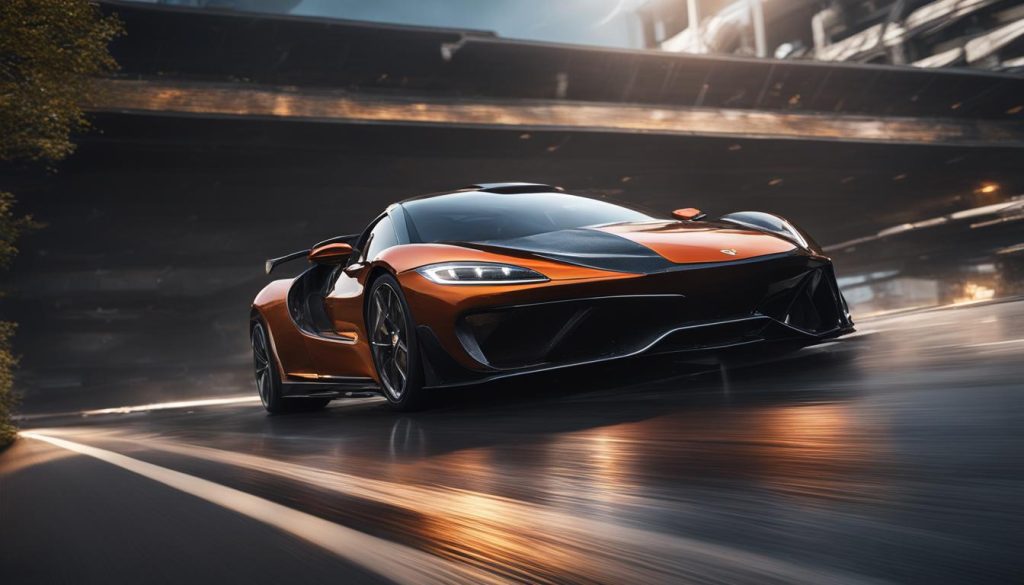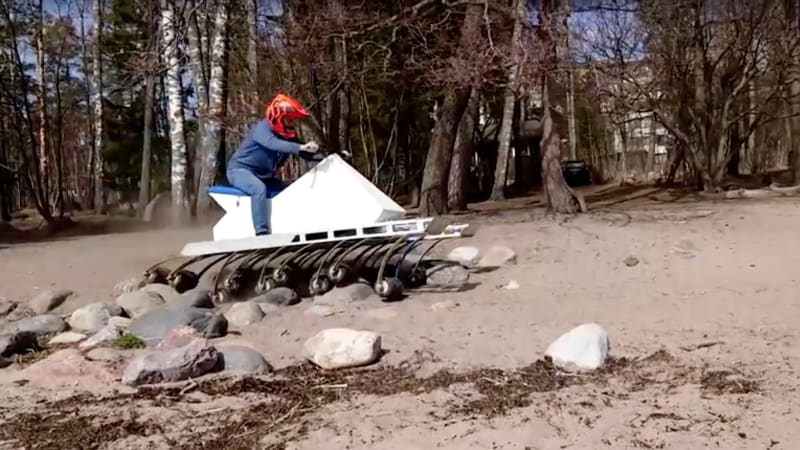
Here’s what driving a Porsche 911 Dakar at Lydden Hill is like. It’s like driving a new Ferrari at Fiorano, or an old Defender at Eastnor, or a thousand-horsepower EV down the dragstrip or a GT86 on a skid pan; so perfectly matched are the car and the environment that’s it’s hard to think of a much more enjoyable place to sample it. In fact, you don’t want to waste brain capacity on alternative scenarios, instead only concentrate on making the very best of this one. Because it ain’t gonna get any better, not for a very long time.
Apologies, then, for those after an objective assessment of this new Porsche 911 derivative. Hopefully, we can do something a little more real world in time, involving a road and traffic and pedestrians, but for now it’s all about the off-road 911 at Lydden Hill. And that’s it: first time seeing the car was in the paddock, the first time driving it was with the cameras rolling, the first time we got into fourth gear it had already gone airborne over a jump. This was not, by any means, a conventional first drive.
But if ever there was a 911 for which the usual rigours of testing can be parked, the Dakar must be it. This isn’t a Porsche sports car that’ll be bought with any sense of rationality involved, surely – you’re buying it because you really, really want it. Even those who get 911s to sell on again would surely be put off by the niche appeal. It’s for all those who want an R/C car they can actually drive – a 953 for the road at last – although just as many will see a cynical (and expensive) rework of a Carrera 4 GTS. There’s little point considering it like a normal Porsche 911 because, despite so many shared bits, the Dakar really isn’t a normal 911. It’s more expensive than a Turbo S, less powerful than a GT3, heavier than a GTS and won’t even do 150mph on the all-terrain tyres. In a very serious and focused 911 line up, it’s a bit of fun, and we’re absolutely here for that. The ‘Roughroads’ livery is still a bit naff, though, especially at £18k.

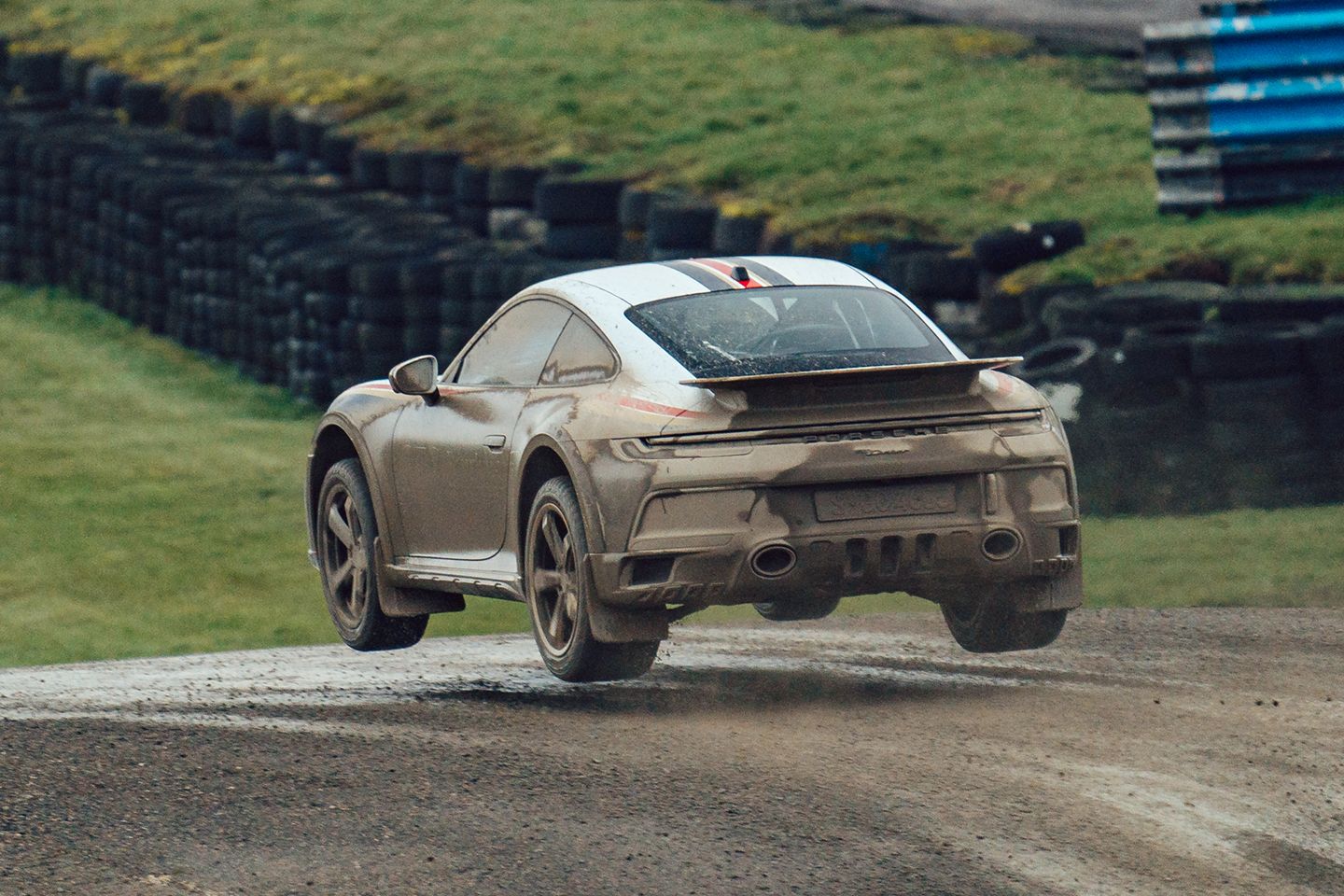
That’s about where the criticism stops, however. Even those customers that will never want their Dakars to see wet grass will enjoy having one, because it’s such a great thing to look at. Of course, it remains recognisable as a 911, but everywhere you look there are details that will raise a smile. Quite whether they’re details worth £170k is another matter, though it’s hard to imagine Dakars are lying around left unallocated. The knobbly all-terrain tyres look perfect on the white wheels, as does the Allroad-style cladding; a raised sports car sounds as silly as the track focused SUV, but there’s undoubtedly something about the Dakar’s aesthetic that works. You’ll pull at the chunky tow hooks and tap the underbody cladding, fling the GT3 bonnet open to see just how light it is and treat the car almost like a full-sized model to start with. Why? Because it seems so unfathomable that Porsche has actually made an off-road 911.
There’s a video coming of the Dakar, and one of the first sentences you’ll hear is along the lines of ‘I can’t possibly drive into there’. Sat low, like in any other 911, and perfectly clasped by a carbon GT3 bucket, your entire body will say this 911 can’t go into Lydden’s swampy centre. The holes are too deep, the rocks too big, the whole endeavour entirely unsuitable to a sports car. Except, of course, it isn’t: the Dakar charges into the first hairpin like it was built to do nothing else, undisturbed by the bumps, and assists deftly in lending a hand, flinging gravel out behind as it finds quite incredible traction in the mire. It’s raised a smile before breaching 50mph.
The suspension and the tyres are the big changes for the Dakar, the car riding as standard 50mm higher than a GTS and with another 30mm possible via a switch on the dash. Fully extended (which our car was for most of the drive, until yours truly remembered about the button), Porsche says the approach and departure angles of this 911 match that of a Cayenne. Incredible. Even with the Pirelli Scorpion All Terrain Plus tyres, a Nürburgring time of 7:56 is claimed; more than 30 seconds off a C4 GTS, but matching a 996 GT3. This is still a seriously fast on-road car, rather than the usual Porsche physics defying car. Just one that can match a Cayenne off-road, too. Rallye and Off-Road modes are unique to this model, the former sending more torque rearwards for your best Jacky Ickx impression, and the latter for ‘high-clearance driving’.
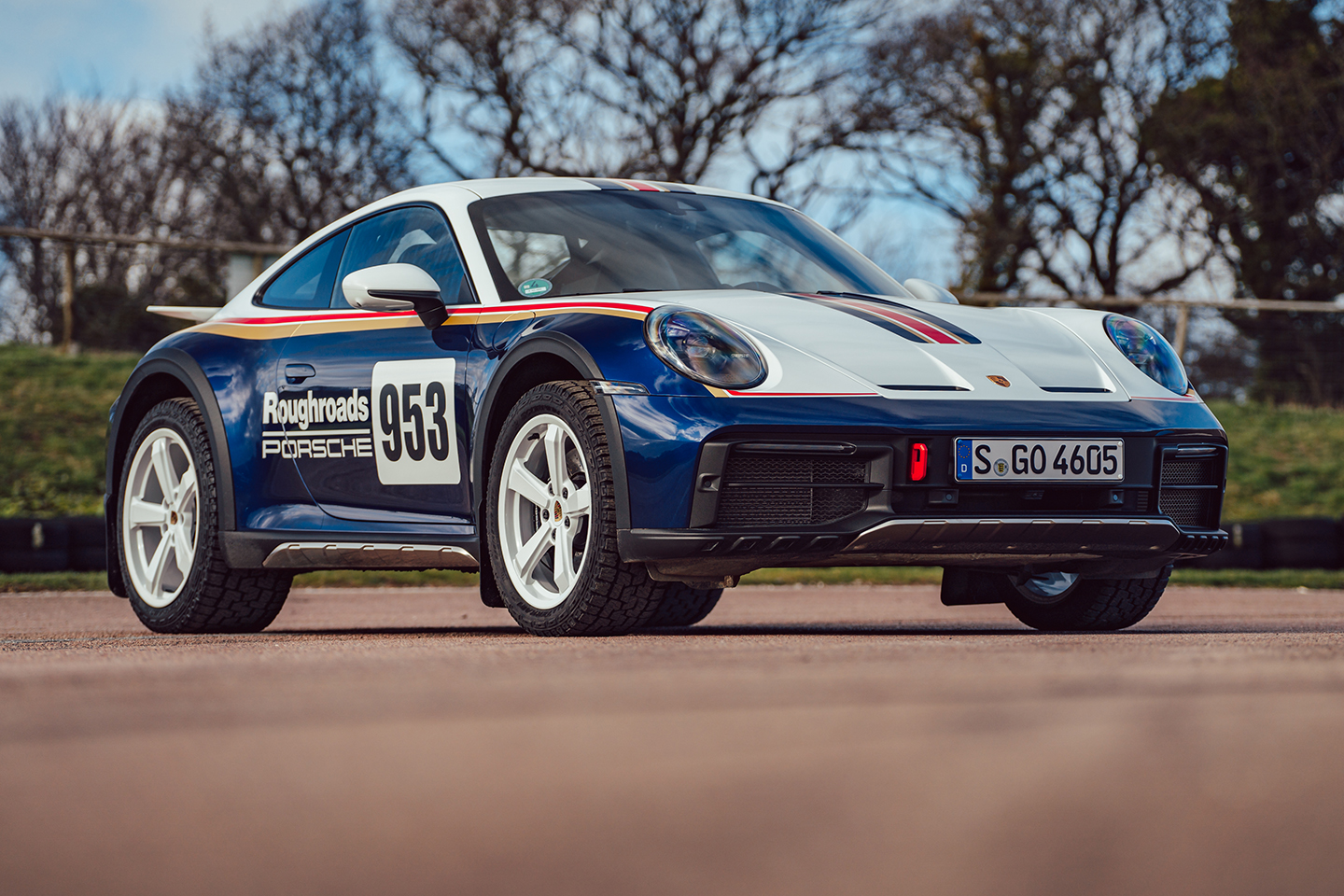
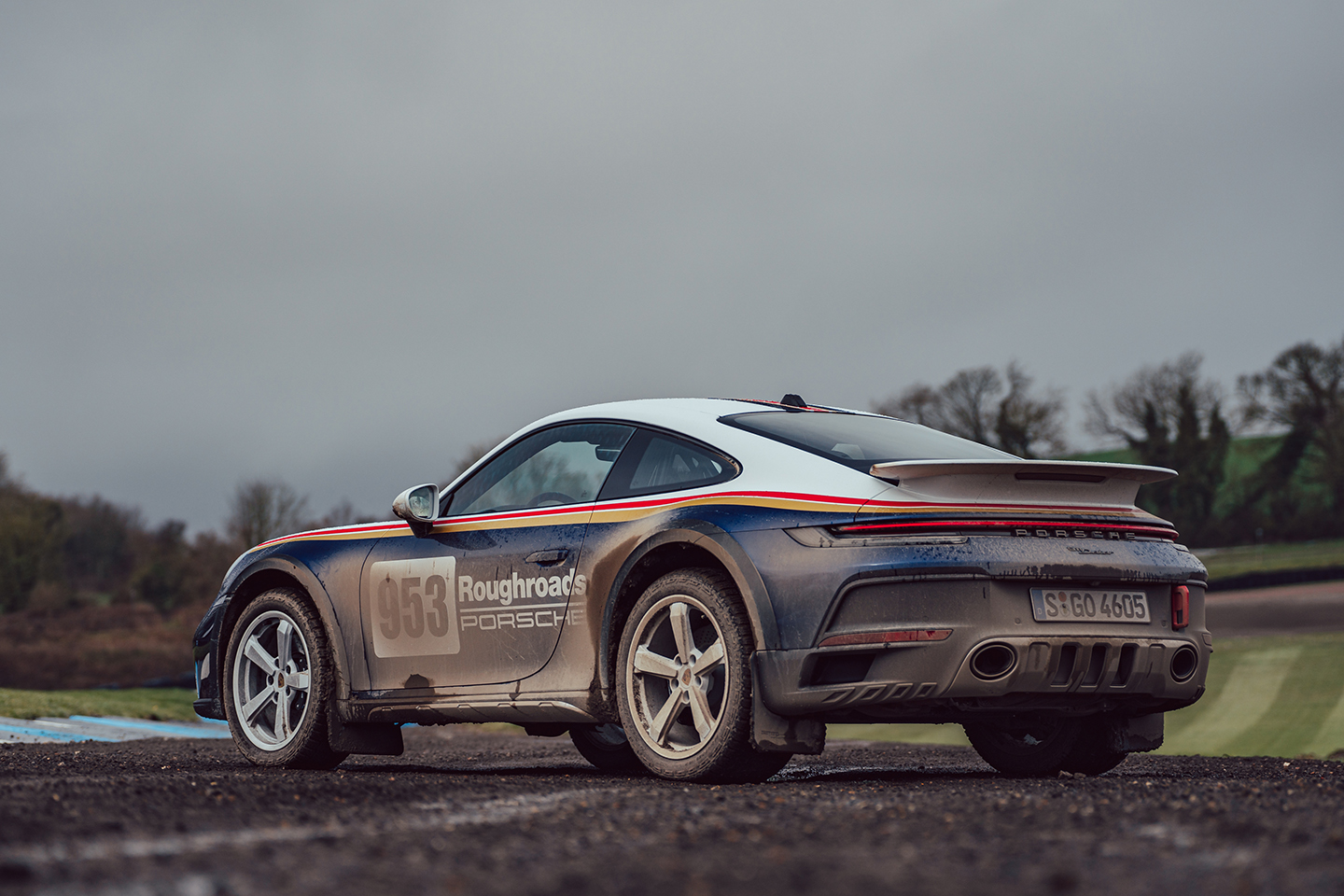
The entire time at Lydden was spent in Rallye and, as is often the case when it comes to Porsche’s chassis electronics, it’s a work of genius. The Dakar feels like a rear-drive racer right up until a bit of extra traction is required to scrabble away from a bend, and it feels like you’re dictating everything that’s going on until a small flash on the dash reveals the truth. Its interventions are about as subtle as could be expected given the car’s remit and the test environment; on a surface slipperier than a two-timing eel, Rallye feels just about perfect for getting some confidence.
The suspension is supremely good. Never in an afternoon of hooning around, whether in the standard setting or firmed up, did the Dakar bottom out, lose its composure, wallow unexpectedly or ever feel remotely like it was out of its comfort zone. The car will lap up the rallycross punishment far better than you; after dozens of jumps I’d had enough, but the car would have kept on going all day – and there wasn’t a squeak, rattle or anything untoward heard, either. The smoke in the paddock is just burning mud, they say. The livery may suggest otherwise, but the Dakar is absolutely a car designed for hard, fast driving, and not mere posturing. I couldn’t have driven it much harder without feeling dangerous, and it was entirely unperturbed. Jump it, splash it, skid it, bop it, the Dakar will come back for more, and be brilliantly entertaining in the process.
Because let’s not forget it’s fast, too, launching to 62mph in just 3.5 seconds thanks to that GTS-donated twin-turbo flat-six. 480hp and 420lb ft absolutely still do the business through its eight-speed PDK. The Dakar sounds better than standard, moreover, a little less sound deadening allowing more turbo whoosh and flat six roar into the experience, like it’s a turbo 911 from the old days.
While the off-road mods have made the Dakar an order of magnitude more capable in the muck, they have also (inadvertently or otherwise) made for a more engaging 911 on the tarmac as well. Lydden Hill tarmac, at least. For years now, die-hard Porsche fans in the media and its customer base have lamented that new 911s don’t really feel like 911s; they’re faster and better sorted than ever, but those quirks that characterise a rear-engined sports car have been ironed out in the process. Not here. In the Dakar the driver can feel the weight distribution with every movement, squatting it down under acceleration and helping it to turn in if you get the braking done right. It’ll understeer when it’s done badly (another thing to witness on the video), especially as the tyres clearly don’t have the bite of a P Zero even with standard four-wheel steer, but that again gives you something to work around and manage as the driver.
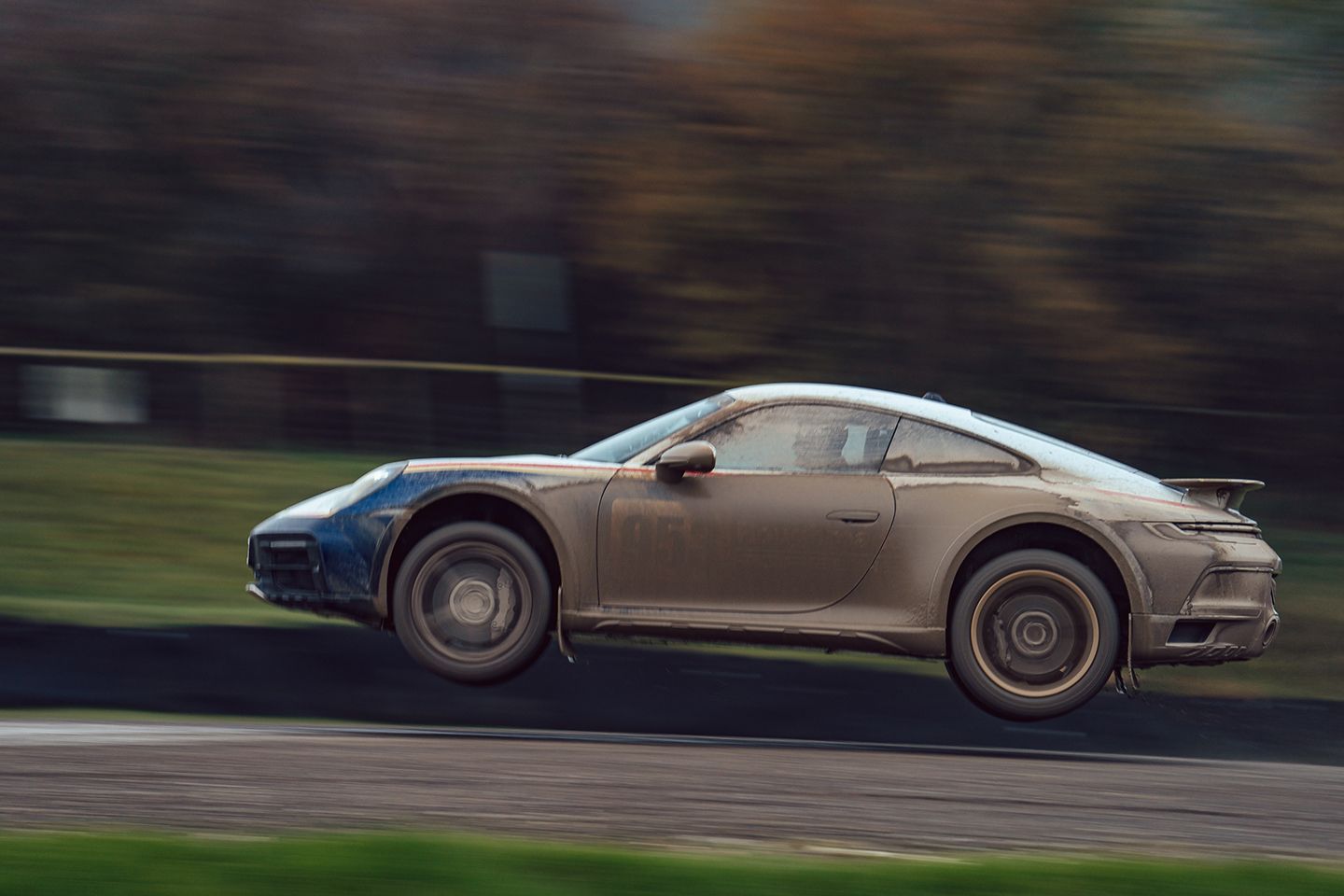
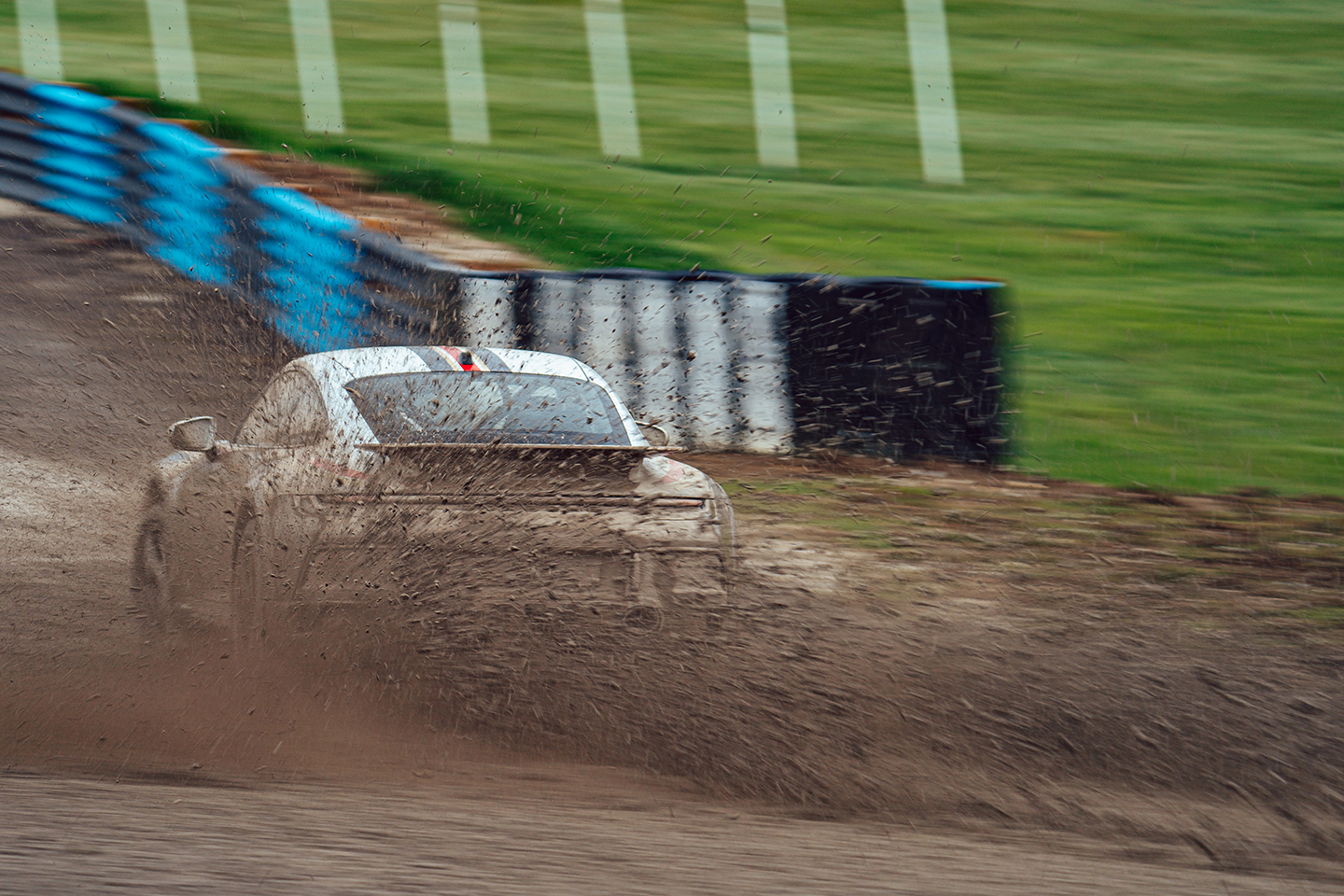
And that’s great. When it does oversteer, the messages that come back are clear and consistent; you can showboat for the camera, or drive in an entertaining fashion that won’t incur the marshals’ wrath at a track day, because the limits are lower but the same precision and finesse of any 911 is here. The experience hasn’t been spoilt by the off-road overhaul; if anything, making a Dakar of the 992 has created a more gratifying driver’s car with more going on. Being a 911 doesn’t impede its rally credentials, at least if this test is anything to go by, and yards more suspension travel hasn’t ruined the Dakar’s appeal as a sports car. That feels a very neat engineering trick to pull off. Even the wealthiest, time richest owner isn’t going to spend their life at Lydden Hill, so it’s nice to know that the Dakar hints at being far more than a one trick pony.
Of course, we could get the car on the road and it’d prove absolutely unbearable, loud, uncomfortable and not very good. I suspect it won’t (and am desperate to find out) but, even if it did, the fun of the Dakar would make it easy to excuse. It makes you smile in a way new 911s seldom do, and that’s before even hitting the mud. In what feels like a less than inspiring time for car enthusiasts that’s to be applauded. Probably the vaguely sensible folk could buy a 911 GTS and a Nomad for similar money, but you wouldn’t want to do a long journey in the Ariel and a regular Carrera is never going to leave the tarmac. The duality here is key. There’s every sign that the Dakar is going to be an absolute hoot whatever it’s tasked with. By broadening the 911’s remit and upping the fun factor without, seemingly, diluting its core appeal, the appeal is plain to see. Even at more than the cost of a Turbo S, because how fast do you actually need a four-wheel drive Porsche to be?
Whether it’s going to be another 911 for the collection, a track car or the everyday sports car, the Dakar will surely shine. We need an actual road drive to be absolutely sure, but it’s hardly like Porsche makes bad 911s these days. There are just some you want more than others. On this experience, prepare to want the Dakar very much indeed, whether you get to jump it or not…
SPECIFICATION | PORSCHE 911 DAKAR (992)
Engine: 2,981cc flat-six, twin turbocharged
Transmission: 8-speed dual-clutch all-wheel drive
Power (hp): 480@6,500rpm
Torque (lb ft): 420@2,300rpm
0-62mph: 3.4 sec
Top speed: 149mph (on all-terrain tyres)
Weight: 1,605kg (DIN)
MPG: 25
CO2: 256g/km (WLTP)
Price: £173,000
#Porsche #Dakar #Review


